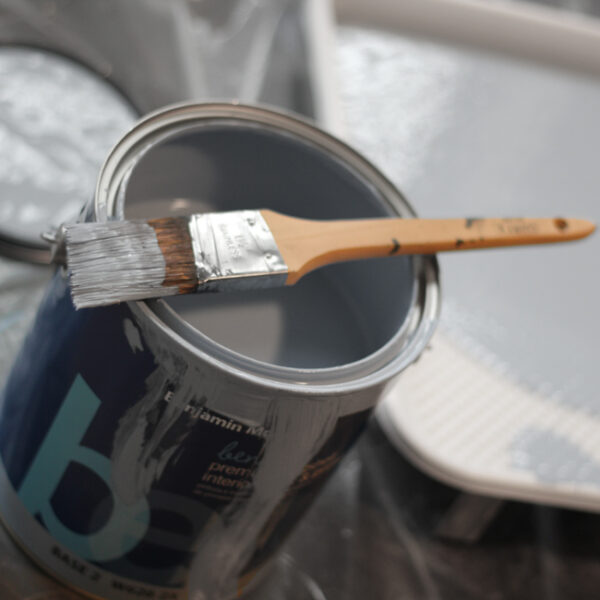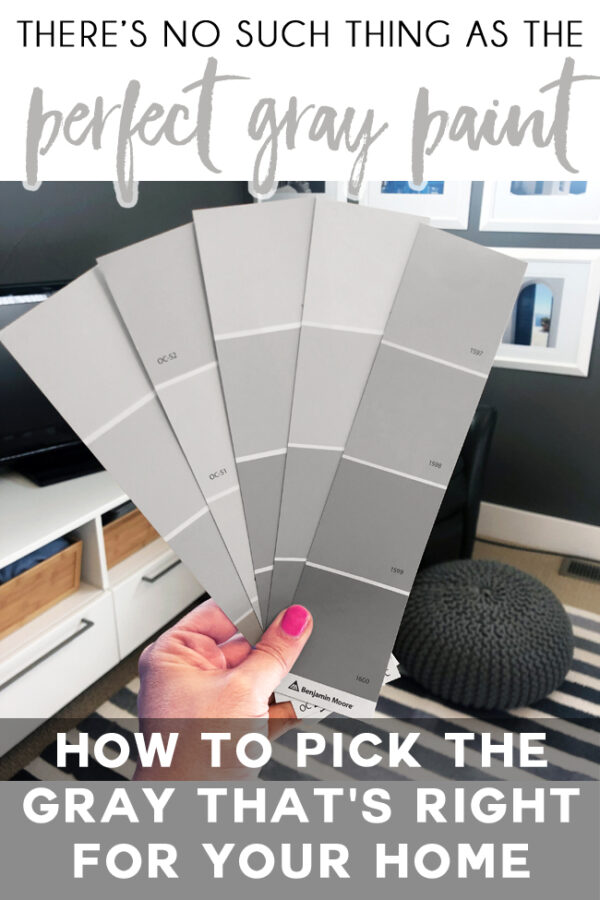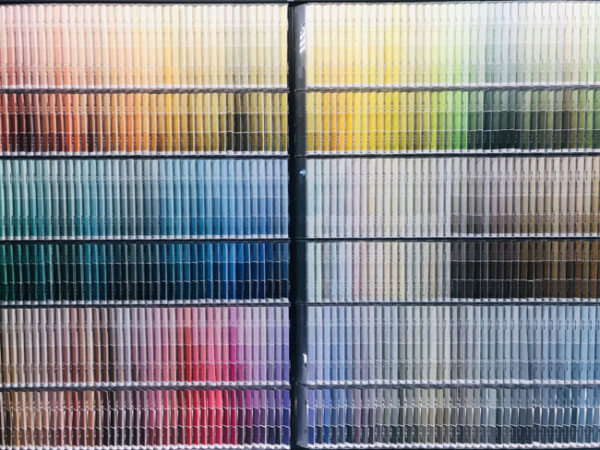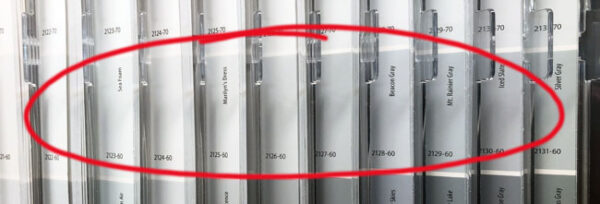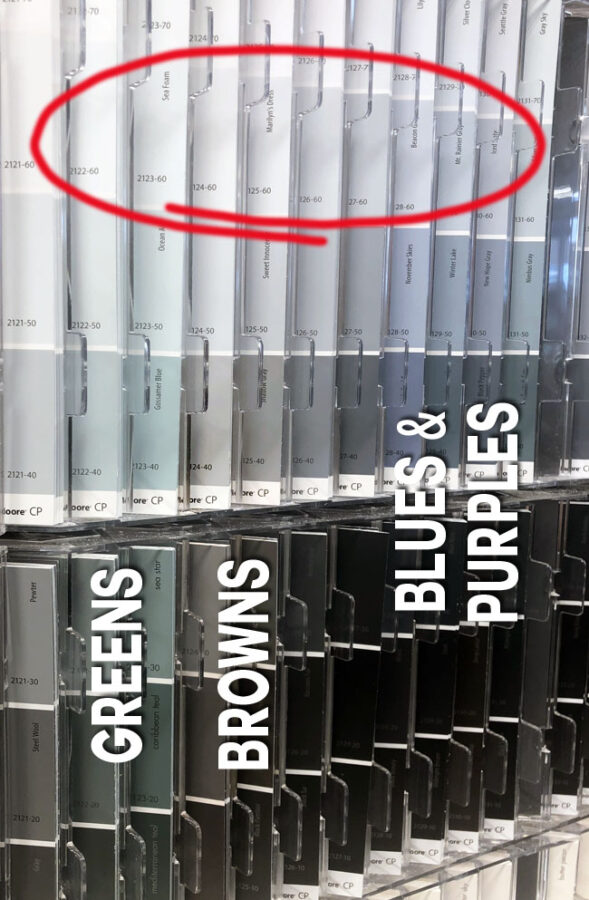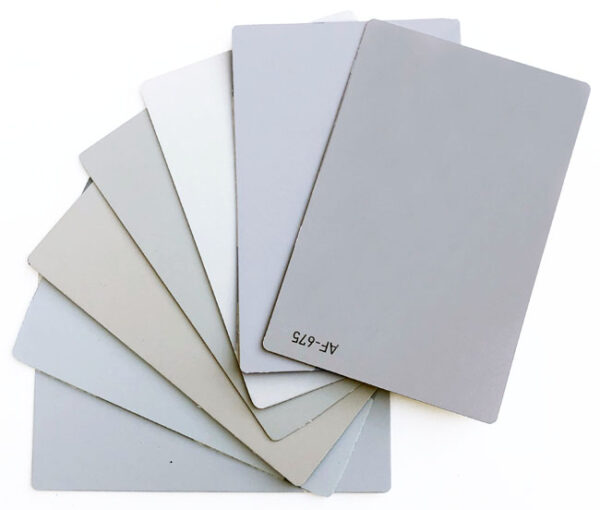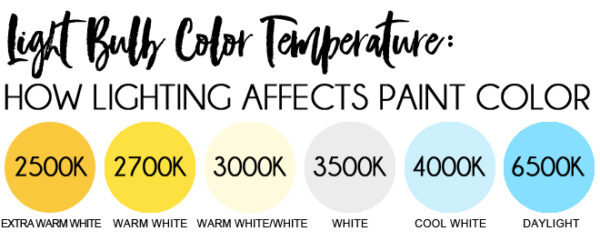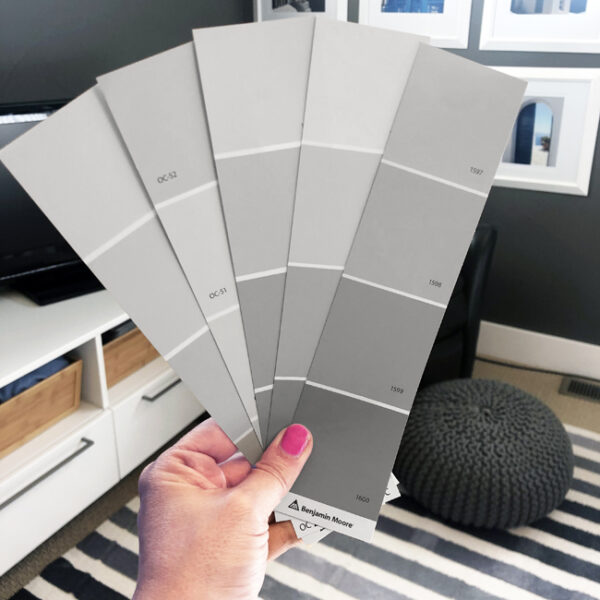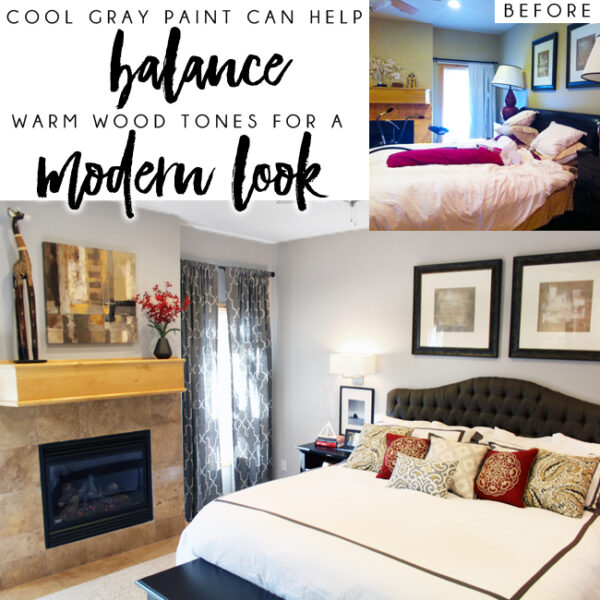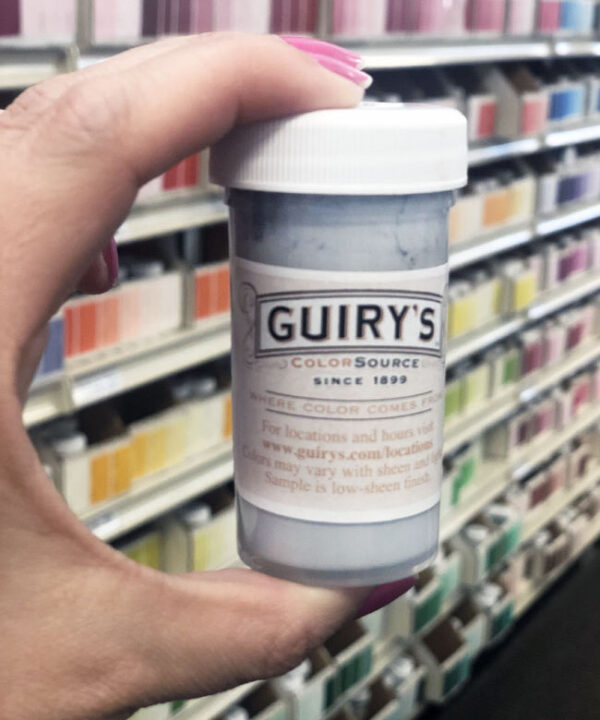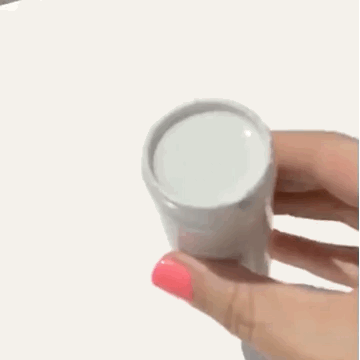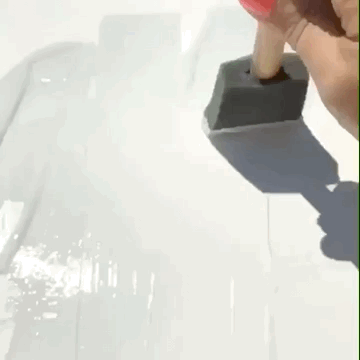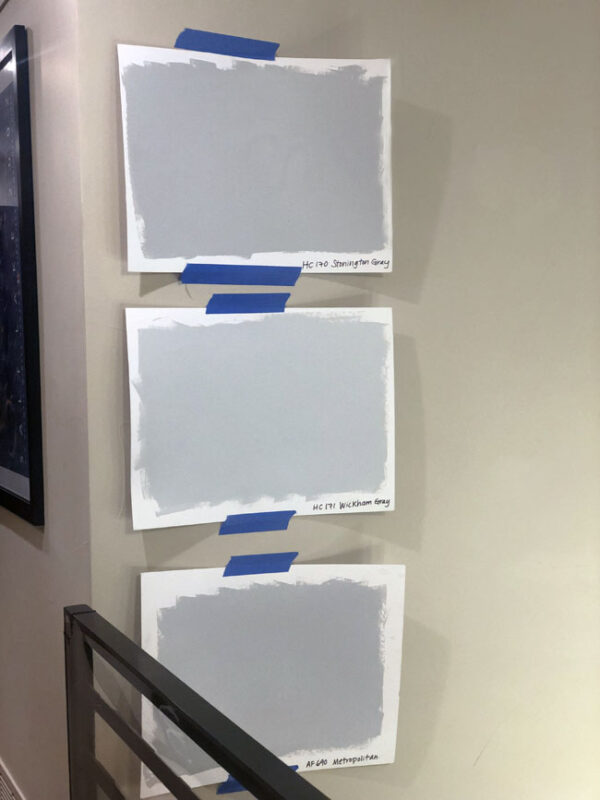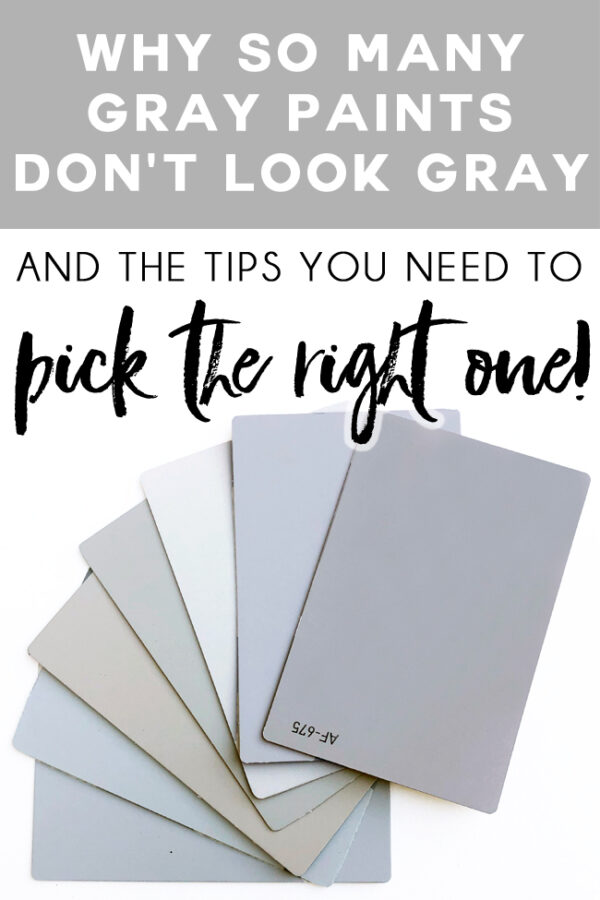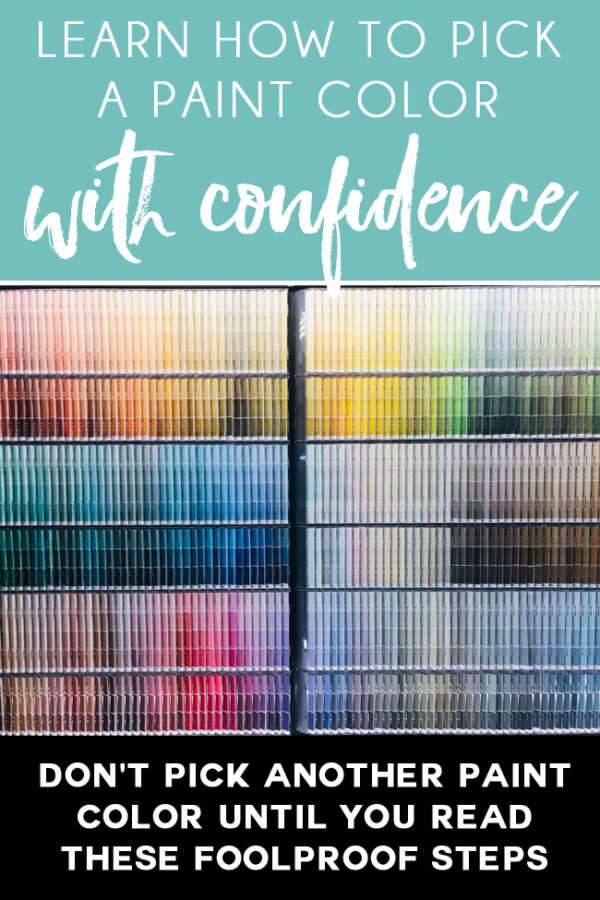Instead of making a list of the “best gray paint colors,” I’ve got some tried and true tips to help you pick the right gray paint for YOUR room!
First, it’s important to understand why it’s so hard to pick gray paint.
A trip to the paint store will lead you to a wide array of swatches with “gray” in the name – but when you start to compare them side by side, it may seem like you’re eyes are playing tricks on you because soon none of them look gray at all!
Understanding Paint Undertones, and Why It Matters
Look Down the Color Card to Find the Undertones
Don’t Look at Paint Swatches in Isolation
In this case, choose a selection of different grays, and lay them down together. When you see all these seemingly-gray grays side by side, you’ll notice that they don’t just look gray any more.
Understanding How Light Affects Paint Colors
Natural Light Is Impacted By the Direction of Your Windows
- North-Facing Windows: Rooms with primarily north-facing windows will get lots of cool, blueish light consistently throughout the day. North-facing rooms typically call for paint with warmer hues to help balance out the cool, shadowy light. Avoid gray paints with cool undertones in spaces with northern exposures. The cool northern light will make gray paint with blue undertones look very blue.
- South Facing Windows: Rooms with south facing windows will get the most direct, high-in-the-sky light throughout the day. If you are lucky enough to have lots of south facing windows, it makes picking paint colors a bit easier because this light works well with both warm and cool tones.
- East Facing Windows: Rooms with east facing windows will get lots of warm, yellow light in the mornings as the sun rises in the sky, and then in the afternoon, as the sun moves west, the light through these windows will be much cooler (bluer).
- West Facing Windows: Rooms with west facing windows will get minimal, shadowy light throughout the morning, and will then be bathed in warm, yellow light in the afternoons as the sun moves lower in the sky.
- How to Strike a Balance in East and West Facing Rooms: As a general rule, gray paints with warm undertones typically look best in east-facing rooms during the afternoon and evening hours, and in west facing rooms, cool toned paints can help balance out the very warm late-day light. But in either of these scenarios, you’ll have the opposite light in the morning. If the room is used all through the day, a gray paint with less dramatic undertones will be the most versatile choice for a neutral appearance from morning to night.
Light Bulb Color Temperature Also Affects Paint Colors
Shopping for light bulbs, and understanding how they’ll look in your home, has become much easier since manufacturers of LED light bulbs have started listing the color temperature (indicated in Kelvin) right on the packaging. The higher the the degrees Kelvin, the cooler the color temperature.
- Soft White / Warm White Light Bulbs (2000K-3000K) – The light produced by these bulbs ranges from orange to yellow-white in appearance. These bulbs will accentuate warm undertones, while muting cool undertones. A “greige” paint that straddles the line between gray and beige will lean much more beige in this warm-toned lighting.
- Bright White / Cool White (3100K-4500K) – These light bulbs produce a more neutral light, with light bulbs around 3500K being the most neutral. As the color temperature starts to approach 4000K or higher, light bulbs will have a slightly blue tint that will begin accentuating the cool undertones in gray paints.
- Daylight (5000K-6500K) – The light produced by these bulbs are intended to mimic daylight, but they have a very cool, blue-white appearance. This color temperature is most often used in retails stores, hospitals, and offices. These bulbs are great for task lighting in garages and work spaces, but can produce a bit of an institutional feel that isn’t well suited for most living areas of the home.
Paint Sheen Affects the Appearance of Color
- Gloss and Semigloss – Gloss and semigloss finishes reflect the most light, which can make a color appear darker.
- Flat – Flat finishes absorb light, which can make a color appear slightly lighter. Additionally, flat paint finishes often have a chalky-appearance when dry.
- Matte and Eggshell – Matte and eggshell finishes provide a balance between glossy and matte that usually result in the the truest match to their swatch colors.
Don’t Rely On Paint Recommendations or Photos
The dramatic impact of lighting is exactly why I cringe every time I read a blog post where someone says, “this color is the perfect gray paint because it has no blue undertone,” but then they proceed to recommend a paint color with a strong yellow undertone. That paint color might be “perfect” for their house, but those same yellow undertones might not work at all in your home.
Likewise, I have a favorite gray paint that doesn’t look at all blue in my house with mostly south facing windows, but when I tested it in a client’s home with north facing windows, it looked downright baby blue.
How to Pick the Right Gray Paint for YOUR Home
1. Always Look at the Paint Swatches In Your Own Home
Choose a Variety of Paint Swatches. Here’s where those recommendations from friends, bloggers, and magazines can come in handy. Grab paint swatches in each of these colors… just don’t stop there. Choose a wide variety of paint swatches and take them home before you start to narrow them down.
Pick Both Warm & Cool Swatches. Even if you think you already know that want a warm or a cool undertone, bring home samples on both sides of the spectrum. I’ve had lots of clients confident that they want a warm gray-beige or a cool greenish-gray, who end up picking something entirely different once they see them in their home.
Look at the Swatches In the Room You Plan to Paint. Once you get the swatches home, take them the room that you plan to paint. Look at them during the day with just natural light, and put a little star on the colors you think you like best.
Then look at all the swatches again at night and make another mark to indicate the those you like best under the artificial lighting in the room. Try to get it down to 4 or 5 swatches that you think have the most potential.
Don’t Look at the Colors in Isolation. In addition to comparing the color swatches to one another {which helps you to identify undertones}, make sure to also compare the color swatches to other items in the room to avoid undertone mismatches.
If you’re painting a bathroom for example, be sure to see how the various colors swatches look next to the tile, the countertop, or the cabinets. If you’re painting a living room, hold the color swatches up next to the couch, pillows, and/or rug. If you already have some gray elements in the room, you don’t have to choose a paint that’s an exact match, but you should avoid shades of gray that clash with one another.
Consider the Existing Finishes in the Room. Also take into consideration the color of wood floors, baseboards and door trim, or carpet. You need to consider whether you want to accentuate the existing color-tones or whether you want to use paint to balance out the these elements in the room.
For example, if you want to modernize a house that has lots of yellow or red-ish wood tones, consider choosing a cooler gray paint. Or if your house has modern elements that are a bit too stark for your taste, consider more of a warm greige (gray-beige) to give the space a cozier feel.
2. Buy Small Paint Samples of the Colors You are Interested In
After looking at lots of paint swatches in the room you plan to paint, and after narrowing it down to 4 or 5 colors you think have potential, you’re ready to buy some color samples.
My favorite local paint shop has an entire wall of 2 oz. sample bottles in almost every color in the Benjamin Moore paint deck. The Sherwin-Williams paint shop in my area, however, does not offer samples like this, but they will mix a sample quart upon request. With many paint brands, you can also order color samples online for convenience, as long as you don’t mind waiting a few days.
3. Create Paint Sample Boards
- The affect of the paint color under your sample. If you’ve ever repainted a room, then you know that it can take several coats of paint to cover the old color. If you paint only a thin sample swatch on your walls to test the new colors, there’s a good chance that the existing color will show through a bit, affecting how the color looks. On the other hand if you paint several thick coats of your sample color in swatches on the wall, you run the risk of leaving ridges on the wall that will show up later when you go to repaint the whole room.
- The affect of the paint color around your sample. There’s an important color theory called metamerism, which basically {in very unscientific terms} means that your eyes will play tricks on you and see color differently based on what’s around it. In this case, if you paint a color sample directly on your wall, the way your eyes see that color sample will be psychologically impacted by the color immediately around it. To get the truest representation of the color, you need to see it against a white background, which is why I leave a white border around each of my sample boards.
4. Look at the Sample Boards at Different Times of the Day and on Different Walls
Also remember that natural and artificial light will work together during certain times of the day, especially in the summer when dusk lasts a long time. Turn light bulbs on even during daylight hours to see what the paint colors look like.
5. Be Patient and Don’t Settle
I know this may seem overwhelming! There’s a reason that gray paint is so hard to pick, and a reason that so many people end up unhappy with their color choice.
As much as I’d love to tell you that there’s one great shade of gray paint out there that looks good in every home, it’s just not the case, and it takes some leg work to pick the one you’ll like best in your home.
If you love the color of the paint during the day, but not under artificial lighting, you can always change the light bulbs to a different color temperature. Once you decide which light bulb color temperature you like best in the room, be sure to make a note of it so you can buy the same light bulbs next time!
While paint is relatively inexpensive, and you can always repaint if you hate it, the time involved or the cost to hire a painter is significant. It’s much better to take the time to choose a color you have confidence in.
How to Pick a Paint Color with Confidence
While this article talks specifically about how to choose a gray paint, you can follow this methodology to pick any paint color. The same principals about undertones and light will apply to any color you choose, and following each of the five steps above will help you to choose a paint you love for your home – no matter the color!
